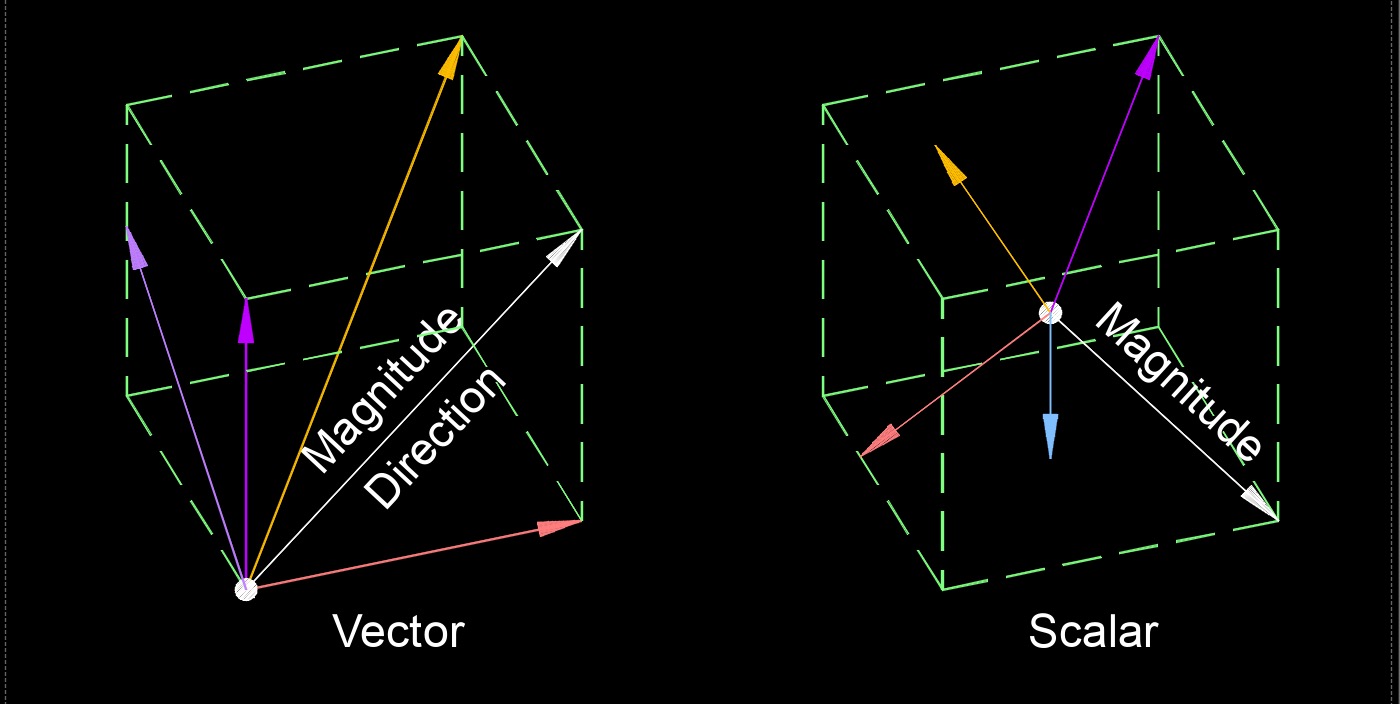Scalar
 In physics and mathematics, scalar is a quantity that is described by its magnitude or size and is independent of any specific direction. Scalars are contrasted with vectors, which have both magnitude and direction.
In physics and mathematics, scalar is a quantity that is described by its magnitude or size and is independent of any specific direction. Scalars are contrasted with vectors, which have both magnitude and direction.
- See Article - Vector
Scalar quantities are characterized by their ability to be added or subtracted using simple arithmetic operations and can be multiplied or divided by other scalars to produce new scalar values. Scalar quantities do not have associated coordinate systems or orientations, and they can be represented by a single number on a number line or as a real number in algebraic expressions.
Here is a list of common scalar quantities: amount of substance, area, calorie, charge, current, density, distance, electric charge, electric potential energy, electric resistance, energy, entropy, frequency, gravitational force, kinetic energy, length, mass, potential difference, power, pressure, resistance, specific heat, speed, time, temperature, volume, volumetric flow rate and work.
Scalar quantities are fundamental concepts in physics and mathematics. Understanding scalar quantities is essential for various fields of science and engineering, as they form the basis for many mathematical and physical principles and calculations.
- Definition - A scalar quantity is a physical quantity that has magnitude but no direction. In other words, it is completely described by its size or magnitude alone.
- Representation - Scalars are typically represented by single numerical values or points on a scale.
- Mathematical Operations - Scalars can undergo mathematical operations such as addition, subtraction, multiplication, and division. These operations are performed based solely on the numerical values of the scalars without considering any directional aspects.
- Units - Scalars are associated with units of measurement that match the property being measured.
- Addition and Subtraction - When adding or subtracting scalar quantities, you simply combine or separate their magnitudes.
- Multiplication and Division - Scalars can be multiplied or divided by other scalars or by vectors. When multiplying or dividing scalars, you operate on their magnitudes algebraically.
- Physical Laws - Many fundamental physical laws involve scalar quantities.
- Measurement Devices - Scalar quantities are often measured using instruments or devices that directly measure their magnitudes.
Similarities Between Scalar and Vector Quantities
Scalar and vector quantities both represent physical properties or measurements, but they differ in how they are described and what information they convey. While scalar and vector quantities share these similarities, their differences are also significant, particularly in terms of the information they convey (direction for vectors) and how they are manipulated in mathematical and physical contexts.
- Magnitude - Both scalar and vector quantities have a magnitude associated with them. The magnitude represents the size or quantity of the property being measured.
- Mathematical Operations - Both scalar and vector quantities can undergo mathematical operations such as addition, subtraction, multiplication, and division. Scalars are added or subtracted directly, while vectors are added or subtracted based on both their magnitudes and directions.
- Representation - Both scalar and vector quantities can be represented graphically. Scalars are represented by a single number or point on a scale, while vectors are represented by arrows indicating both magnitude and direction.
- Units - Both scalar and vector quantities are associated with units of measurement. Scalars have units that match the property being measured, while vectors have units that match the combination of properties being measured.
- Physical Meaning - Both scalar and vector quantities describe physical properties or measurements of objects or phenomena in the physical world. Scalars describe quantities like distance, speed, temperature, energy, etc., while vectors describe quantities like displacement, velocity, force, acceleration, etc.
- Mathematical Framework - Both scalar and vector quantities are integral parts of mathematical frameworks used to describe physical phenomena. Scalars are represented as single values, while vectors are represented as arrays of values or as mathematical objects with magnitude and direction.

Tags: Nomenclature and Symbols